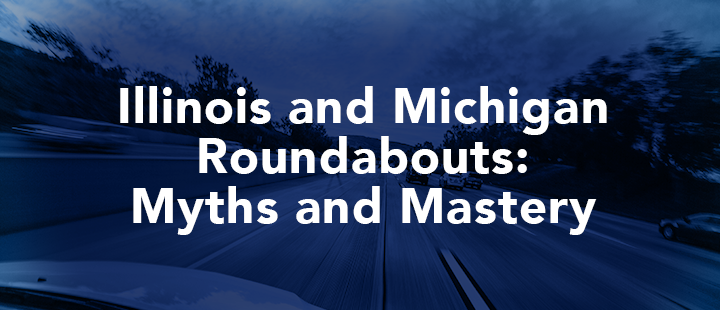Illinois and Michigan Roundabouts: Myths and Mastery
Do you dread roundabouts? Does the idea of even executing a roundabout make your heart pitter patter? You aren’t alone. Read further for why many roadways have roundabouts and the 5 common myths about them.
What is a Roundabout?
Modern roundabouts differ vastly from older traffic circles. The older method involved a convergence of roads together in a center; whereas, the modern roundabout features a steady flow to prevent lock up, which was common with older traffic circles. For instance, people entering the traffic circle had the right of way, which caused significant back-up. The “through road” often cut across the circle of the traffic circle, which disrupts fluidity.
With modern roundabouts, people yield upon entry so that drivers in the roundabout do not get locked up. There are additional lanes to allow for merging and exiting. Roundabouts fell out of favor because of the older models; however, modern roundabouts are quite safe. There are several myths surrounding roundabouts that are still circulating.
Myth 1: Roundabouts Are Difficult to Navigate
Using a roundabout is similar to making a right turn at a red light. At a red light, the driver stops and looks to the left for oncoming traffic. If there are no cars present, the driver may turn right. Entering a roundabout is the same. A driver needs to yield to traffic that is in the roundabout and enters when there aren’t any approaching vehicles. The driver is then in the roundabout and may exit as needed, which is also a right turn.
Myth 2: Roundabouts Are Expensive
Costs to build a roundabout are nearly equal to what they cost to set up a traffic light; however, traffic lights incur ongoing expenses. Roundabouts do not need extra costs to maintain it save for asphalt or other minor patch work at a later date. Roundabouts are far less expensive in the long-run.
Myth 3: Roundabouts Are Dangerous for Pedestrians to Cross
Roundabouts are significantly safer for pedestrians to cross. In a standard crosswalk, pedestrians need to be aware of cars making right turns at the stoplight, and they need to pay attention to traffic that is coming from opposite directions. In addition, a crosswalk can be anywhere between two to five lanes wide. A roundabout has splitter islands in the middle of each crossing. Also, roundabouts only have one direction of traffic, which makes it safer for pedestrians to cross. In addition, since pedestrians have a shorter space to cross, drivers are more aware of them when they cross than if they were crossing a standard crosswalk.
Myth 4: More Accidents Occur in Roundabouts
Actually, less accidents occur in roundabouts. More accidents occur in standard intersections and streets than in roundabouts. 75% less accidents occur at roundabouts than at traditional intersections with lights. The reasoning for having them is to actually make pedestrians and cyclists safer.
Myth 5: Roundabouts Take Time to Navigate
Roundabouts save people time. They are steadily flowing. The most time people spend in commuting to work is spent at stoplights. If people had to use roundabouts to commute to work instead of stoplights, they could possibly shave between 10 and 20 minutes from their commute time.
Reduce your speed and be aware of your surroundings when entering roundabouts. Traffic already traveling in the roundabout have right of way, you must yield to them. Although you should slow down, you shouldn’t come to a complete stop. Stay vigilant for pedestrians who may be at the crosswalk—pedestrians have the right of way.
Tips For New Drivers Navigating Roundabouts
When selecting your lane in a roundabout, just think logically. If you are going straight or right, get in the right lane. To go straight or left, get in the left lane.
Over the past few years roundabouts are becoming more common throughout the Midwest, so it’s important to get comfortable with navigating roundabouts early on. For parents, this means making sure to include roundabouts on the route you take during your teens practice driving hours. It’s important they are comfortable with roundabouts before they can drive on their own. For teens, make sure to take it slow and check both ways for cars and pedestrians before entering the roundabout.
View this video for navigating a multi-lane roundabout, provided by WisDOT.
About Top Driver in Illinois and Michigan
With over 40 locations, Top Driver Driving School offers more driver education classes and driving lessons than any other driving school in the Midwest. We give you the flexibility to choose the driver education classes that best fit your schedule, from teen driving to adult driving school to driver education online.
Contact us to learn more about our services in your area!
